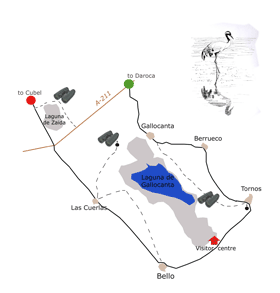Gallocanta Lagoon
Starting point: The village of Gallocanta
Time: 3 to 5 hours.
Time of year: November to March is the best period.
Leave Gallocanta on the road to Berrueco, shortly taking a track on the right signed "El Camino del Cid". This track can be followed to Tornos and offers the best possibilities for viewing the northern side of the lagoon and the surrounding fields. On the shores of the lake waders like Kentish Plover, Grey Plover and Greenshank may be present, while the birds on the lake itself depend very much on the water level (the lake may be virtually dry) and the time of year.
In the winter months look out for Greylag Goose, Shelduck, Red-crested Pochard, Pintail, Wigeon, Tufted Duck and others, while summer or passage visitors may include Black-necked Grebe, Black-winged Stilt, Avocet, Little Ringed Plover, Montagu's Harrier, Whiskered Tern, Gull-billed Tern and Dotterel.
Calandra Lark and Black-bellied Sandgrouse can be found along the path before reaching Tornos, and Hen Harriers and Golden Eagles are frequent winter visitors.
The visitor centre on the right hand side of the road between Tornos and Bello is worth a visit. Further on, the general area between Bello and Las Cuerlas regularly attracts largish numbers of Great Bustards in the non-breeding season.
The star attraction of the lagoon however are the thousands of Cranes that gather in the evenings, above all from January to March. The Buen Acuerdo hermitage between Las Cuerlas and Gallocanta is one of the most suitable locations to watch the comings and goings of these impressive birds.
The itinerary can be completed by visiting the nearby La Zaida lagoon (although there is rarely any water here!) or the small lagoon of Guialguerrero near Cubel.


